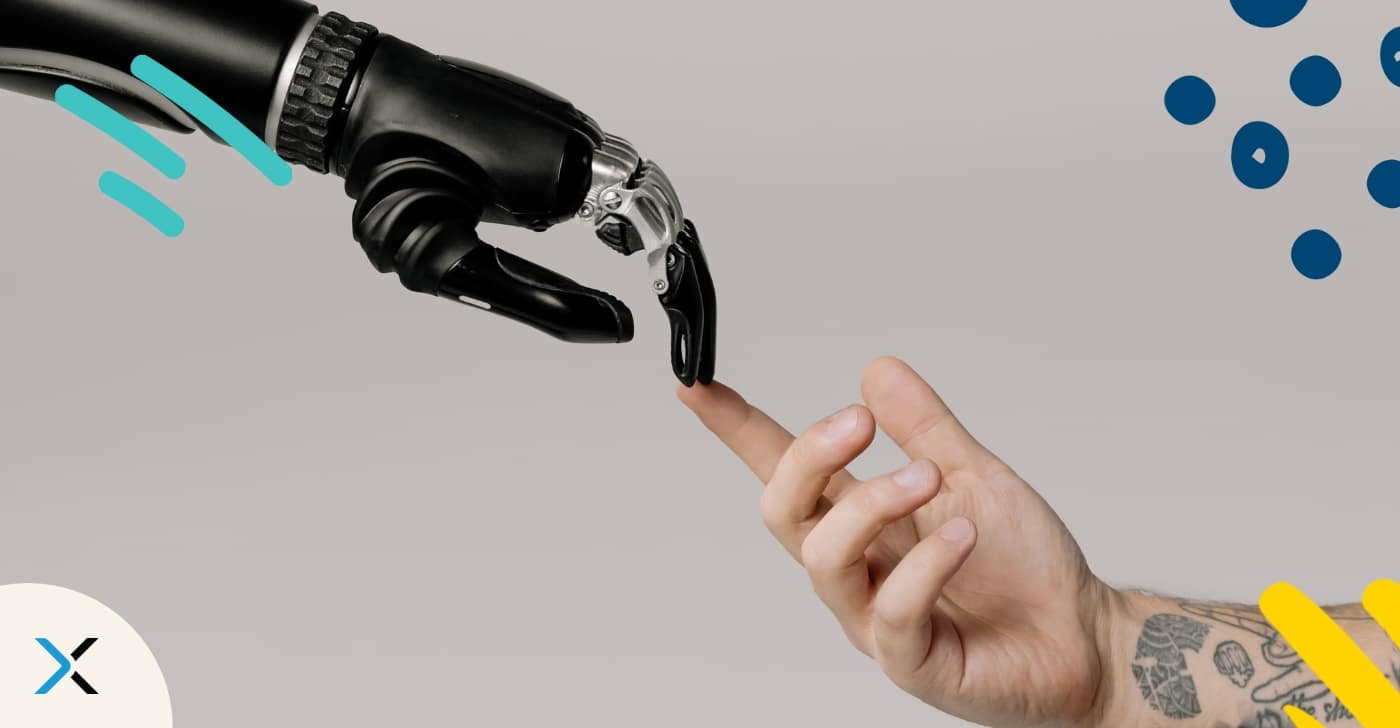
As Artificial Intelligence continues to infiltrate the modern workplace, we need to stop asking ourselves “Are human workers being replaced by AI tools?” instead it’s time to ask, “How can humans and AI work together to enhance critical thinking and produce better content?”
It doesn’t have to be a one-or-the-other type situation. Oftentimes, the most desirable result comes from some level of human and AI collaboration. The writer (human) has unique personal experiences that only they can understand and provide context on. The tool (AI) can identify patterns in vast data sets, offering key findings and quick summaries.
Combining human creativity with the sheer computing power of AI systems is the perfect recipe for creating impactful content — whether it’s for marketing, support, or product documentation. Let’s explore the concept of human-AI collaboration, why it matters in enterprise workflows, and how to maximize AI collaboration in your business for lasting success.
What’s human-AI collaboration?
Human-AI collaboration refers to the synergy between human intelligence and AI capabilities to achieve outcomes neither could accomplish alone. Humans bring creativity, strategic thinking, and emotional intelligence to the table. While AI excels at processing large amounts of data, automating repetitive tasks, and offering insights based on patterns.
In enterprise environments, human-AI interaction isn’t about machines taking over — it’s about augmenting human capabilities. For example, AI writing tools like Acrolinx assist writers by suggesting content improvements, identifying compliance issues, and helping with style and terminology consistency — allowing human writers to focus on high-level thinking and creativity.
This drastically speeds up decision-making processes, as writers have the comfort of knowing they have an extra layer of oversight built into their workflow.
What’s collaborative AI?
While human-AI collaboration specifically focuses on the interaction between humans and AI, collaborative AI refers to a broader concept. It encompasses any AI system or agent working together — be it among themselves or with humans to accomplish tasks or solve problems more efficiently than they could on their own. The objective of collaborative AI is to either combine the strengths of human and machine intelligence or leverage the combined strengths of multiple AI systems. Through collaboration, these synergies produce outcomes that neither could achieve individually.
In a business context, collaborative AI could mean a set of AI systems working together to streamline processes or solve complex problems, often across different departments or teams. For example, an AI-powered platform may work alongside other AI tools or integrate seamlessly into a team’s workflow to improve efficiency and reduce manual effort.

Key areas where collaborative intelligence transforms work
You’re likely accustomed to the rise of AI technologies nowadays, but are you familiar with all the different ways to use them? Here are some ways human employees can leverage AI in the enterprise:
Streamlining content creation
AI tools help writers generate ideas, check for grammatical errors, safeguard consistency, and even suggest ways to improve clarity and engagement. By doing so, AI takes care of the heavy lifting, allowing writers to focus on creativity and high-level strategy.
Enhancing data analytics
AI processes and analyzes substantial amounts of data quickly, which is incredibly useful for decision-making. AI collaboration helps businesses sift through large data sets, extract meaningful insights, and present them in an actionable way for human teams.
Improving compliance monitoring
Compliance is a critical concern for enterprises, especially those operating across multiple regions. Collaborative AI tools, like those found in content creation platforms, automatically check content for compliance with various regulatory standards, making sure that businesses meet legal requirements without needing constant human oversight.
Automating repetitive tasks
Many enterprise workflows are bogged down by repetitive, time-consuming tasks. AI automates these processes — whether managing emails, scheduling meetings, or generating routine reports — allowing human workers to focus on higher-level tasks that require critical thinking.
Customer service automation
AI-powered chatbots and virtual assistants can handle customer inquiries, troubleshooting, and even simple technical support tasks. When combined with human agents, this creates a seamless customer service experience where AI deals with routine queries, and humans step in for more complex issues.
How to maximize human-AI collaboration in your enterprise
You’ve gotten a small taste of the power of AI and human collaboration — now it’s time to develop a strategy for facilitating it. Before you reap the benefits of AI collaboration, you must ensure you have the budget, necessary AI tools, and buy-in from the broader organization. Here’s how to make the most of human-AI collaboration in your organization:
- Set clear roles for AI and humans: Clarify early on who will be in charge of what tasks so there is no confusion down the road. For AI, consider things like mundane tasks, content suggestions, and compliance checking. Leave the creative thinking, brainstorming, strategic thinking, and final approvals to the human.
- Customize AI tools for your specific needs: AI tools should be tailored to your specific business requirements. Customizing AI platforms to suit your industry standards, terminology, and compliance needs significantly improves the relevance and effectiveness of the output. For example, Acrolinx can be fine-tuned to align with your brand voice, preferred terminology, and regulatory requirements, making the AI work seamlessly within your organization.
- Continuous training and development: The more information AI consumes, the more it grows. Continuously train your AI models using fresh, relevant data to ensure they remain accurate and useful. In content workflows, regularly reviewing AI suggestions and performance helps fine-tune its ability to generate high-quality, compliant content. As your AI system becomes more sophisticated, it will enhance collaboration and productivity even further.
- Create a human-AI feedback loop: One of the things that makes AI systems so special is that they learn and evolve very quickly. As you interact with AI tools, provide feedback on the suggestions and improvements the AI offers. This creates a loop of continuous improvement, where both AI and humans learn from each other. For example, if an AI tool suggests a particular style change that doesn’t fit, make sure to tell it! The tool will avoid any suggestions in that style moving forward.
- Invest in AI literacy: You won’t get much out of AI collaboration if your team doesn’t know how to use the tools properly. Encourage AI literacy across your organization, providing training sessions and resources on using the tools to enhance productivity and quality. Make sure to establish best practices, dos and don’ts, and guardrails. When employees understand AI’s capabilities and limitations, they are better equipped to use it as a valuable collaborator.
- ALWAYS review AI outputs: AI is an incredible tool for streamlining workflows and increasing output, but it is by no means a foolproof solution. You should always ensure humans oversee the output before finalizing any documentation. For example, content suggestions made by AI tools may need to be reviewed for relevance and alignment with business goals. Setting up periodic checks and audits will make sure that AI-enhanced content or processes always align with your standards and objectives.
Level up human-AI collaboration with Acrolinx
Looking to evolve your human-AI collaboration efforts? Acrolinx takes your content workflows to the next level with AI-powered precision and human creativity. Here’s how Acrolinx helps solve key pain points:
- Real-time content suggestions: Offers instant feedback to align content with brand guidelines and tone, speeding up the review process.
- Terminology management: Standardizes terminology across all content to safeguard consistency across teams and regions.
- Easier translation: Improves the quality and translatability of your source content, making sure your global content is accurately translated and culturally relevant.
- Compliance and regulatory checks: Automates compliance monitoring to reduce legal risks and meet regulatory requirements.
- AI-powered content scoring: Provides insights on content quality to identify gaps before final approval.
- Seamless integration: Integrates easily into your existing workflows, enhancing productivity without disruption.
- Content analytics and reporting: Tracks content performance, helping you make data-driven decisions to improve strategies.
With Acrolinx, human-AI collaboration is streamlined, efficient, and compliant, allowing your teams to create high-quality content faster. Check out our eBook on how to effectively collaborate with AI without risking losing your job!

Are you ready to create more content faster?
Schedule a demo to see how content governance and AI guardrails will drastically improve content quality, compliance, and efficiency.
The Acrolinx Team




